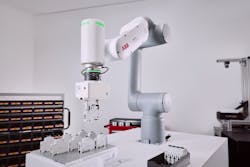Global cobot sales expected to climb through 2028
By Bruce Geiselman
Global collaborative robot revenues in 2019 totaled about $669 million, and sales are expected to swell to about $1.94 billion by 2028, accounting for 15.7 percent of the total robot market, according to industry analyst Maya Xiao.
Xiao, a senior analyst covering cobots for Interact Analysis, outlined her projections in a 2021 report. Xiao’s 2022 report won’t be released until April, but she told Plastics Machinery & Manufacturing that growth has been greater than she had predicted last year.
2020 was tumultuous because the pandemic closed many factories and warehouses and caused businesses to postpone capital investments, she said. That year, cobot sales fell for the first time, with a revenue decline of 11.3 percent and a shipment decline of 5.7 percent. However, sales rebounded in 2021 with a growth rate between 20 and 30 percent, Xiao said. A more precise figure will be included in her upcoming report. The rise in sales was particularly pronounced in the second half of 2021; similar growth is expected in 2022, she said.
“The market is running better compared to our previous projection,” she said.
She believes that growth will continue.
“If we’re talking about unit shipments, it’s growing quite fast,” she said. “It’s like two-digit growth annually. It’s not only for these two years, but it’s forecasted to be for the next five or six years that we still enjoy a very high growth rate.”
The plastics and rubber industries accounted for about 7.8 percent of cobot revenues in 2020, Xiao said. She suspects that the rate of growth in sales to the rubber and plastics industries might be slightly less than the overall projected growth because some sectors, like logistics and the service industry, are seeing even stronger growth. Growth in cobot sales to the rubber and plastics industries over the next five years likely will range from 15 to 20 percent, she said.
Cobots are experiencing a much higher rate of growth than traditional industrial robots, she said. Their advantages include built-in safety features for working alongside humans and flexibility, because a cobot can easily be moved from one workstation to another.
“The third [advantage] is it’s very easy to use,” Xiao said. “A big, heavy industrial robot needs programming and maintenance. There should be a technical team to do the coding to make the arm do [for example] the painting or welding.”
The pandemic will continue to drive sales as manufacturers adopt automation to increase social distancing and help reduce risks to workers, she said. Another driver is the labor shortages in North America, Europe and the Asia-Pacific region.
Interact Analysis is an international market research company with offices in the U.S., the United Kingdom and Asia.
Contact
Interact Analysis, Austin, Texas, 512-598-0087, [email protected], www.interactanalysis.com
More on automation
Automation is on every manufacturer’s mind these days, or it should be. There’s more to our Cover Story:
• Processors hustling to add more robots to their mix. https://plasticsmachinerymanufacturing.com/21258332
• Worker shortage, advancements in technology fuel cobot sales. https://plasticsmachinerymanufacturing.com/21257916
• Veteran manufacturer of EAOT says automation is now accessible to anyone. https://plasticsmachinerymanufacturing.com/21256653
• A project manager or integrator can help make your robot installation a success. https://plasticsmachinerymanufacturing.com/21258310
• The future is automated, according to Jeff Burnstein, president of the Association for Advancing Automation. https://plasticsmachinerymanufacturing.com/21256667
• Robots don’t kill jobs; they free humans to move into better ones, experts say. https://plasticsmachinerymanufacturing.com/21258504
• Rapid Robotics’ subscriptions offer an affordable way to start automating your plant. https://plasticsmachinerymanufacturing.com/21258285
• Yaskawa enhances features on two new products. https://plasticsmachinerymanufacturing.com/21256712
• Epson’s easy programming lowers the barrier to entry. https://plasticsmachinerymanufacturing.com/21258503
• Three case studies show cobots’ versatility. https://plasticsmachinerymanufacturing.com/21258453
About the Author
Bruce Geiselman
Senior Staff Reporter Bruce Geiselman covers extrusion, blow molding, additive manufacturing, automation and end markets including automotive and packaging. He also writes features, including In Other Words and Problem Solved, for Plastics Machinery & Manufacturing, Plastics Recycling and The Journal of Blow Molding. He has extensive experience in daily and magazine journalism.
